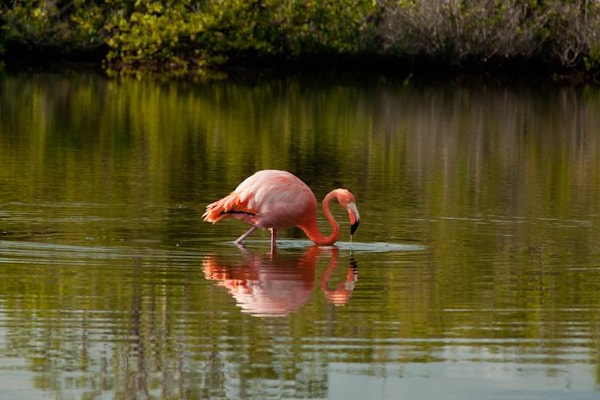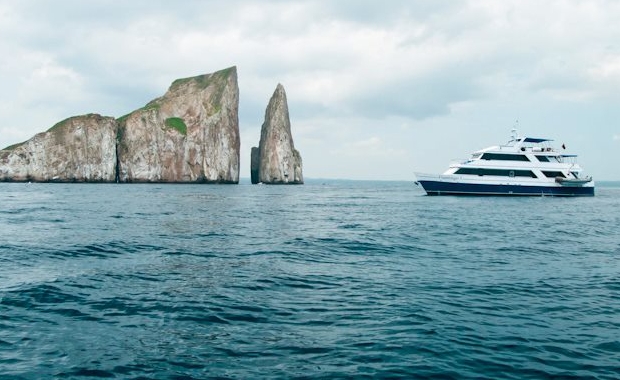Stretched along the equator, west of Ecuador, the Galapagos Islands’ 18 volcanic islands bask under blue skies for the majority of the year, making them a great place to travel to anytime. The islands were formed some 3-10 million years ago by volcanic activity that burst through the earth’s crust, creating a fascinating archipelago. Their isolated position, some 900km off the coast of Ecuador, and the movement of seven major marine currents have made the Galapagos Islands a unique breeding ground for animals and plant wildlife. These islands are home to a large number of endemic animals and plants which have adapted to their particular conditions over hundreds and thousands of years. When naturalist Charles Darwin traveled to the Galapagos in 1835, he was amazed by the different animals he found within the same species, and his observations became pivotal in the development of his theories on natural selection and evolution. Discover the wonders of the Galapagos Isles & wildlife in this guide for a unique insight into this spectacular destination.
Recognition as a National Park by the Ecuadorian Government, protection by UNESCO as a World Heritage site, and the constant study and observation by the Charles Darwin Foundation, have meant that the Galapagos Islands are the most ecologically intact oceanic archipelago on earth. It is no surprise that the Galapagos are a popular travel destination with regular cruises setting of to explore the distinct islands. Wildlife enthusiasts visit the Galapagos Islands to see the unique and surprisingly people-friendly animals found there. Here is a brief summary of the main islands and of which animals you can expect to find where on a Galapagos Islands Cruise.
Santa Cruz Island

Santa Cruz Flamengo
The second largest island of the Galapagos archipelago and with its central location the main tourism hub for all of Galapagos. Many Galapagos visitors arrive on the Baltra airport and will from there on board one of the luxurious Galapagos yachts. Santa Cruz has a great variety of geology, wildlife and vegetation and is known for its peculiar flora and lava tunnels.
Highlights
Charles Darwin Foundation Center –
Highlands & Tortoise Reserve – One of the best opportunities to see wild Tortoise on Santa Cruz Island is the Tortoise Reserve.
Black Turtle Cove – Board one of the smaller boats to reach the Black Turtle Cove, this is where sea turtles feed and mate and as well 3 species of sharks can be spot.
Dragon Hill – Related to the conservation program of the Charles Darwin Foundation and the Galapagos National Park, this visitor site opened in 1993 and is still a great place to observe land iguanas.
South Plaza – The smallest of the 2 Plaza Islands and a very popular visitor site. South Plaza Island houses many species, as sea lions, land iguanas, marine iguanas, red-billed tropicbirds and many more.
Wildlife
Black turtles, sea turtles, sharks, flamingos and land iguanas.
Baltra Island
Land Iguana Balta Island
Together with Santa Cruz Islands, Baltra is home to one of the airports that connect the Galapagos Islands with the mainland. The island is also called South Seymour and one of the flattest of the Galapagos archipelago. Much vegetation including salt bushes, cacti and Palo Santo trees grown on Baltra.
Wildlife
Land iguanas, boobies and frigatebirds.
North Seymour and Bartholomew Islands
Blue Footed Boobies North Seymour
Both of these islands are smaller and younger than the other islands in the Galapagos, but amongst the most visited and most photographed islands. Two very interesting sites can be visited and the wildlife on both islands is perfect for birdwatchers.
Highlights
Pineapple Rock – Both the northern and southern beaches aside of the Pineapple Rock are perfect places to spot wildlife such as green turtles, penguins and sharks. Note that swimming is only allowed at the northern beach. A small hike upon the rock will be awarded with amazing views.
Wildlife
Blue footed boobies, Nazca boobies, swallowtail gulls, pelicans, Galapagos penguins, Galapagos Hawks, herons and green turtles.
Isabella Island
Giant Tortoise Isabella Island
This is the largest island, formed of six volcanoes that have merged together and taken the shape of a sea horse. Nowadays relatively new lava field can still be seen around the island, this relatively recent volcanic activity has given this island rich fauna, that is incomparable to any of the other islands in the archipelago. Each of the volcanoes is home to another species of wild
Highlights
Sierra Negra – The black mountain thanks its name to the recent lava flows, that can be walked over by visitors. The views of the manu volcanoes of both Isabela and Fernandina Islands are just incredible from here.
Elizabeth Bay – The perfect place to snorkel, as the waters are very quiet which makes it possible to spot sea turtles. Here you will also see many other species, as flightless cormorants, penguins and pelicans.
Wildlife
Galápagos penguins, flightless cormorants, marine iguanas, pelicans, Galapagos tortoises, Darwin finches, Galapagos doves, hawks, whales, dolphines, sei, minkes and orcas.
San Cristobal
Frigatebirds San Cristobal
The first island Darwin visited on his voyage of the Beagle and partly because of that home to the oldest permanent settlement of the Galapagos Islands. The other reason is the small fresh water source, also named El Junco that can be found near the top of the island.
Highlights
Interpretation Center – a very complete collection of the history of the Galapagos Islands and all you need to know about its flora and fauna can be found at the Interpretation Center. It’s the perfect introduction to the Galapagos Islands.
Frigatebird Hill – After a short walk from the Interpretation Center you will find yourself up Frigatebird Hill, the ideal place to learn about the Magnificent Frigate Birds and the Great Frigate Birds.
Isla Lobos – Quite a boat ride from San Cristobal but definitely worth it! This is the nesting place for blue-footed boobies and frigatebirds, and also sea lions can be seen. Don’t forget to bring snorkel equipment!
Cerro Brujo – Another perfect place to snorkel and to relax at the coral sand beaches. Climb up the rock after a swim and watch the many migratory birds.
Wildlife
Frigate birds, giant tortoises, sea lions, blue and red footed boobies, marine iguanas, dolphins and swallowtail gulls.
Española Island
Albatross Espanola Island
As the oldest island and most secluded, this island is home to the highest number of endemic species in the Galapagos Islands. The animals found here are not found on any other island, which makes it one of the most popular visitor sites of the archipelago. Española Island also has a beautiful beach, great for snorkeling and swimming.
Highlights
Punta Suarez – Be prepared to be welcomes by a colony of sea lions! The variety of wildlife around Punta Suarez is incredible, red and green marine iguanas, Espanola Lava Lizards, Galapagos Hawks, Espanola Mockingbirds and Lava Lizards can all be found here. Oh! Let’s not forget to name the Waved Albatross colony, which is one of the highlights of a Galapagos Island visit, make sure to visit Punta Suarez in between April and December.
Gardner Bay – The best beaches on Española Island can be found at Gardner Bay, swim, snorkel and enjoy the expansive beaches and unique wildlife.
Wildlife
Lava lizard, mockingbird, tortoise, marine iguanas and waved albatross.
Stay tuned Class Adventure Travel will shortly be launching numerous new Galapagos Islands Cruises. This guide may be of a help while selecting your ideal Galapagos Cruise, anyhow feel free to contact one of our Travel Specialist in order to plan your perfect Galapagos Cruise or for any questions that haven’t been answered yet.
